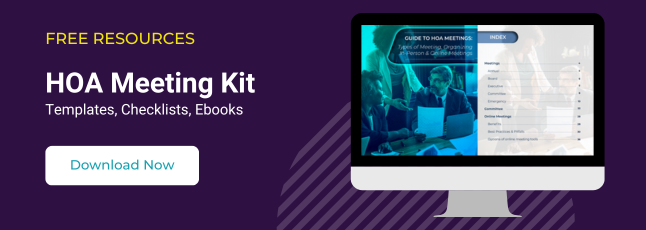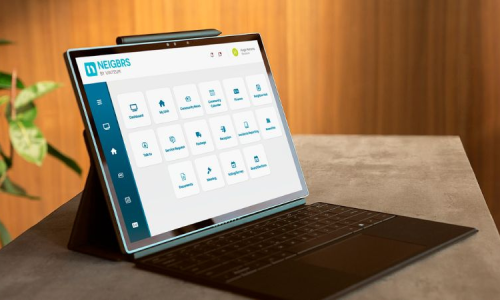An HOA annual meeting is a crucial event in a community. This is where important discussions take place.
In this blog post, we explore essential strategies for making the most out of your annual meetings. We take you through practical steps, covering preparation, meeting execution, and post-meeting actions.
Learn how to ensure efficiency and success in every phase of the process.
What is an HOA annual meeting?
An HOA annual meeting is a significant yearly gathering. This is where the community collectively addresses key matters to shape its year. Members discuss important matters such as the annual budget, major projects, and committee reports. It’s also usually when the election of board members takes place. How, when, and where an HOA annual meeting happens depends on the association’s governing documents and the State’s laws.
Best practices to plan and run an efficient HOA annual meeting
To ensure a successful HOA annual meeting, you need to take different steps before, during, and after the event. In this section, we’ll explore the key strategies for each stage.
Before the HOA annual meeting
Understanding Your Governing Documents
Start by getting familiar with your community’s governing documents. They hold the key to when the meeting should happen, how it should unfold, and what needs to be done beforehand. For instance, they might outline exactly when to send out notices and agendas. In many communities, sending out these notices and agendas a certain number of days in advance is required . So, not only do your HOA rules act as your roadmap, but they also set the pace for timely and organized meeting preparations. And don’t forget to check your State’s laws as they might add extra layers to your meeting planning.
Use a Timeline
Using a timeline for your meeting preparation can help you efficiently manage various tasks and responsibilities. Having this visual representation of milestones arranged chronologically helps you avoid forgetting anything. For example, you can add different dates and assign responsibilities for tasks such as:
- September 1st: Preparing notices and agenda
- September 10th: Sending out notices and agenda
- September 15th: Putting up HOA meeting signs & add information to the HOA website
- October 1st: Send reminder to homeowners about the meeting (via email, SMS, or smart calls)
- October 5th: Preparing documents
- October 8th: Send reminder to homeowners about the meeting (via email, SMS, or smart calls)
- October 10th: Day of the meeting
- October 20th: Reviewing the suggestion box
- November 1st: Distributing draft meeting minutes
A timeline ensures that every crucial task, from sending out notices to wrapping up after the meeting, gets the attention it deserves. Each board member is aware of their responsibilities and the deadline.
Here is an image below that shows what a timeline looks like.
Notify Residents Efficiently
Getting everyone on board for the meeting requires a good heads-up. Use multiple communication channels for this. Notices, email reminders, community bulletin boards, and newsletters are your allies here. The more HOA communication channels you use, the better the turnout. And when it comes to HOA meetings, a good turnout means reaching quorum effortlessly.
During the HOA annual meeting
Record Meeting Minutes
The person in charge of taking the minutes, usually the HOA secretary, should write down discussions, decisions, and any action points on the agenda. For instance, if there’s talk about a new community project or budget allocation, meticulous minute-taking ensures a comprehensive record. This detailed account becomes an invaluable resource for referring back to. It helps to track progress and ensures nothing important slips through the cracks.
It’s an excellent way to promote transparency among members. Residents who couldn’t attend can easily access the minutes and understand the discussed topics.
Follow Meeting Etiquette
Having proper HOA meeting etiquette ensures a respectful and productive gathering for all participants.
For example, keeping an eye on the time is essential – it helps the meeting stay on track. This ensures all topics are covered without making the meeting drag on. It also shows respect for participants’ time.
Another important aspect is to make everyone feel at ease. Encouraging residents to share their thoughts is essential for meaningful discussions.
When it comes to manners, make sure to be polite. Listen to what others say, don’t raise your voice, and wait for your turn to speak. This makes the meeting a nice and fair place for everyone.
If someone’s behavior lacks respect, you can politely request them to be more considerate of the well-being of the meeting.
Implement a Suggestion Box
Moving forward, consider adding a suggestion box to the mix. This could be a physical box or a digital platform – a virtual space where community members drop in their thoughts and ideas. Imagine this as an interactive board where residents contribute suggestions for improving community spaces or proposing new initiatives. This simple addition transforms the meeting into a collaborative effort. It can increase community engagement and ensure diverse voices are part of the decision-making process.
If discussions are going off-topic, as a board member, you can recommend adding this topic to the suggestion box. This way, it can be considered and discussed at another gathering.
After the HOA annual meeting
Distribute Draft Meeting Minutes
In some states, HOA meeting minutes must be made available to members within 30 days. It is important to note that these minutes may not be the final version, as in many states and associations, meeting minutes from the prior meeting must be approved at the next meeting. Minutes that haven’t been approved yet may be referred to as “draft minutes” or “minutes proposed for adoption.”
In any case, if your association rules and state laws permit, we recommend you to promptly share the meeting minutes. This ensures that everyone is well-informed about what transpired, decisions made, and action items identified during the meeting. Just be sure to follow the rules outlined in your governing documents and state laws.
Read Suggestion Boxes
Take the time to review the contents of the suggestion boxes, whether physical or digital. This provides insights into the community’s thoughts and concerns, fostering an environment of open communication.
Make sure to follow up on the suggestions. Address these topics in another meeting, conduct a survey, or mention them in the newsletter. If you don’t take action, it may impact the trust members have in the board.
Follow Up on Action Items
Act on the identified action items promptly. This may involve implementing decisions, initiating projects, or addressing concerns raised during the meeting. Timely follow-up contributes to the effective execution of plans and demonstrates a commitment to community improvement.
Learn from Potential Mistakes
Reflect on the meeting’s proceedings and outcomes. Identify any challenges or areas for improvement. Learning from mistakes ensures continuous growth and improvement of future meetings. It helps make each HOA annual meeting more effective and beneficial for the community.
Wrapping up on HOA annual meetings
Mastering the strategies outlined here ensures your HOA annual meetings are efficient, transparent, and inclusive. From meticulous planning to attentive execution and thoughtful follow-up, each step contributes to a successful gathering. Embrace these practices to foster engagement, and guarantee the continual improvement of your HOA annual meetings.





